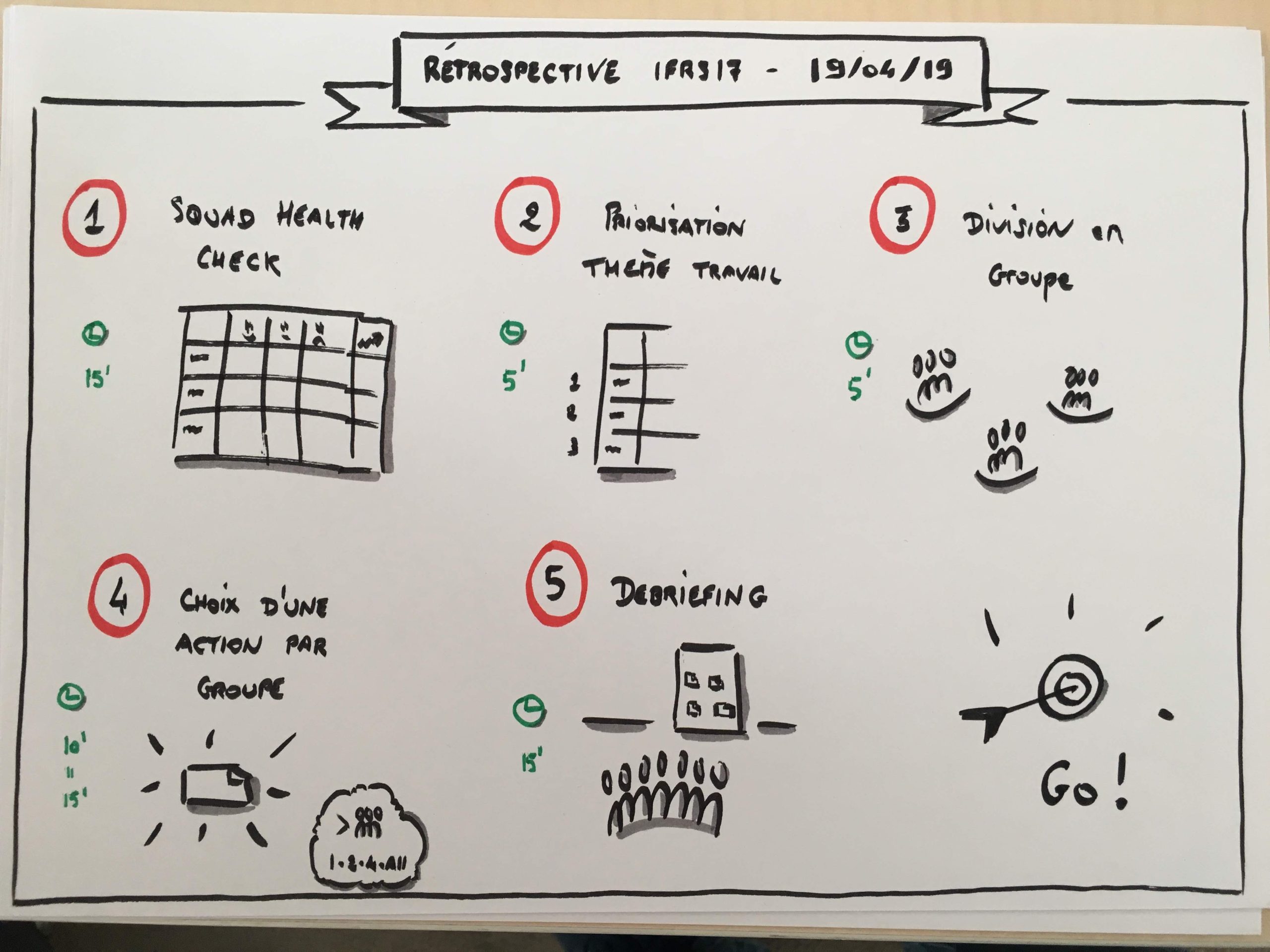After a few weeks in the presence of this team, it seemed interesting to me to take the time to study where it was at rather than rushing on potential ideas for improvement.
I therefore proposed to him for this second retrospective a framework around the Squad Health Check in order to be able to benefit from more precise themes to study together.
Here is a description in this next article!
In the same series:
- 30 people, one hour: some retrospective formats (Part 1)
- 30 people, one hour: some retrospective formats (Part 2)
- 30 people, one hour: some retrospective formats (Part 3)
Retrospective 2: Squad Health Check

Preparation
- Select Deck Themes original Or translated of the Squad Health Check to submit to the team
- Print and cut these cards in advance in order to prepare the results support on Paperboard
| Note: There are different translation versions of the deck in French. It turns out that I chose the one from Fabrice Aimetti because it included additional themes that seemed interesting to me to take up within the framework of this retrospective. Thanks to him ! |
Animation
(2′) Introduction and presentation of the framework
As with every event, the initial impetus matters a great deal. I clarify the framework and recall the intentions as well as the rules of the retrospective with regard to the past iteration.
(5′) Overall satisfaction with the iteration

Unexpectedly, I thought it might be interesting to have a general feeling of the assembly vis-à-vis the iteration that had just passed. It is also an attempt on my part to generate more transparency within the team.
To make it as fast as possible, I proposed to each person to position themselves on a score from 0 to 5 corresponding to their level of satisfaction with this last iteration:
- 0 corresponding to "If there was a window, I'd probably go out that way!" »
- 5 corresponding to “I have never felt so good in my life! »
| Note: of course, this is said in a humorous tone! |
The intention here is twofold:
- allow everyone to fully understand the rule set out
- prepare participants for the Squad Health Check operating on the same principle
In terms of animation, I simply took each number one after the other and asked the group directly for the people positioning themselves at this place by a show of hands. I write down the results as I go along and let the participants take note of the results.
After shedding light on the current sentiment of the team, we move on to the next step.
(20′) Squad Health Check
After explaining how the workshop works (which you can find here), I pass successively on the following topics:
- Deliver value
- Ease of delivery
- Fun
- Code Health
- Learning
- Assignment
- Pawns or Players
- Speed
- Adapted process
- Support
- Team work
- Trust
- Discipline
There are a lot of themes to tackle here, so in terms of facilitation, the idea was to quickly go through each of them and visually materialize the results for the whole team.
The people did not all express themselves for all the subjects and I considered that ok. Indeed, the idea is simply to establish a first basis of conversation, so we are not looking for precision in itself but rather to observe trends.
| Note: It can be particularly uncomfortable to raise your hand to express a negative sentiment on a topic in front of a large group. I took the side of hoping that the people most affected would take their responsibilities to come forward but, I am aware, it was a gamble. Now it worked pretty well! 😛 |
(3′) Voting and selection of study topics
After we get all the results, we simply do a Dot Voting and select the study topics that the team will split into subgroups.
Here is the team's result in photos:

| Note: You may notice that it is not necessarily the "least" highly rated themes that have been selected. I think that's what I appreciate in this kind of exercise, it's that it's not always the rational that wins, but rather what the team has considered to be the most important theme. more important to study together at that time, with hindsight! 🙂 |
(15′) Sub-group work
Not surprisingly, I reuse the mechanics of 1-2-4-All in order to bring out an action by subgroup to be implemented in the next iteration.
| Note: not only this Liberating Structure seems particularly useful to me, but my intention is also to transmit this tool to the teams so that they can use it on a regular basis if necessary, hence the repetition! 🙂 |
(15′) Debriefing
Each team shares the results it has obtained as well as the associated action. I facilitate discussions somewhat by rephrasing and clarifying.
The session is then closed.
Conclusion
This retrospective based on the Squad Health Check seems to me to be a simple and still formidable facilitation format.
Now, in the context of an animation with a large number of people, the challenge lies above all in the good selection of the themes to be approached and in the facilitation of the group in order to respect its timeboxes and its general timing.
The use of 1-2-4-All is probably the main mechanism allowing me to save precious time in the phases of collective reflection: I accept in this way that not everyone will participate in all the conversations. At the same time, I hope to be able to increase the chances of implementation of actions by focusing people on a single subject and defining a collective team responsibility in the follow-up.
This concludes this second article in the series.
See you next week for the third and final article describing another retrospective format I used with this team! 😉






